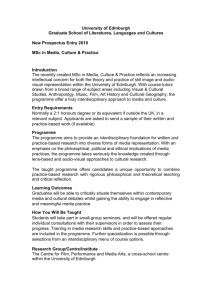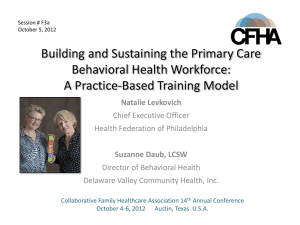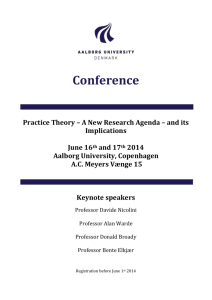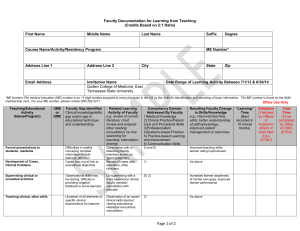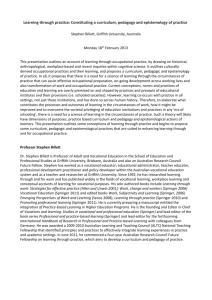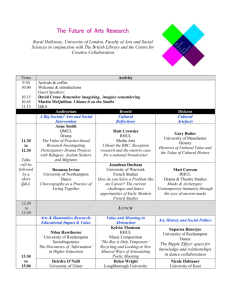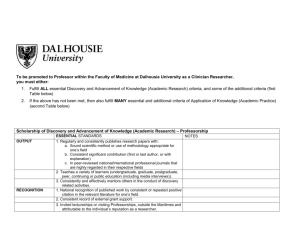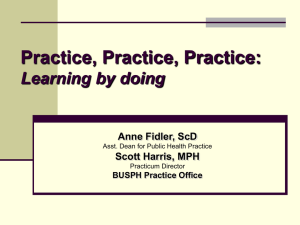Training for Practice-Based Research
advertisement
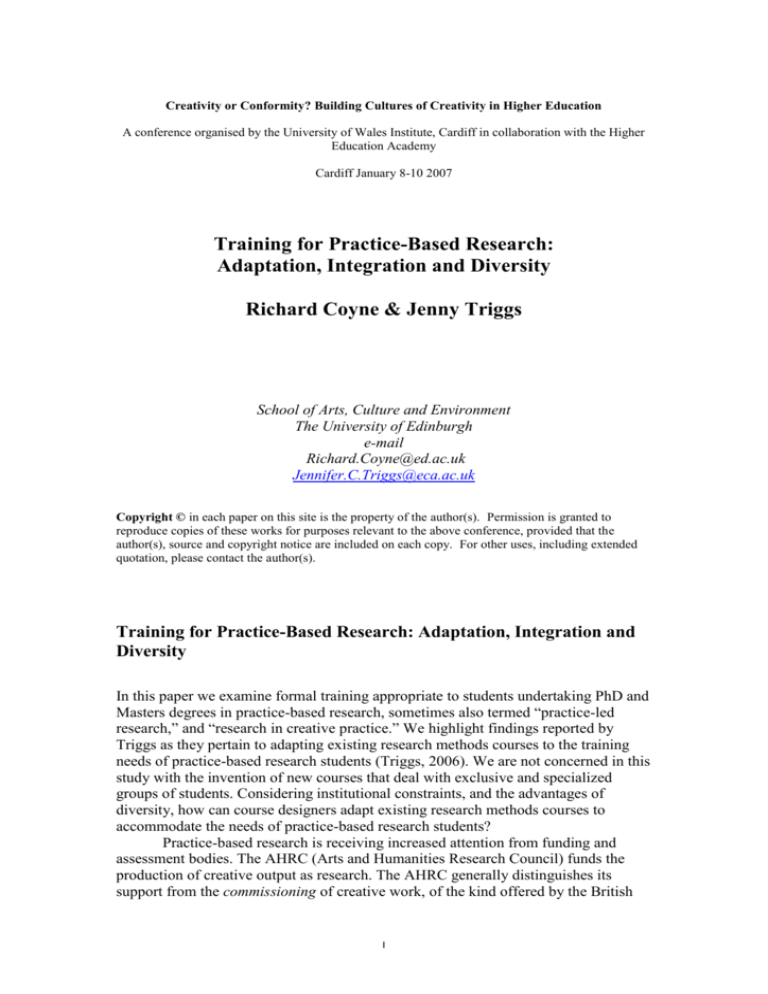
Creativity or Conformity? Building Cultures of Creativity in Higher Education A conference organised by the University of Wales Institute, Cardiff in collaboration with the Higher Education Academy Cardiff January 8-10 2007 Training for Practice-Based Research: Adaptation, Integration and Diversity Richard Coyne & Jenny Triggs School of Arts, Culture and Environment The University of Edinburgh e-mail Richard.Coyne@ed.ac.uk Jennifer.C.Triggs@eca.ac.uk Copyright © in each paper on this site is the property of the author(s). Permission is granted to reproduce copies of these works for purposes relevant to the above conference, provided that the author(s), source and copyright notice are included on each copy. For other uses, including extended quotation, please contact the author(s). Training for Practice-Based Research: Adaptation, Integration and Diversity In this paper we examine formal training appropriate to students undertaking PhD and Masters degrees in practice-based research, sometimes also termed “practice-led research,” and “research in creative practice.” We highlight findings reported by Triggs as they pertain to adapting existing research methods courses to the training needs of practice-based research students (Triggs, 2006). We are not concerned in this study with the invention of new courses that deal with exclusive and specialized groups of students. Considering institutional constraints, and the advantages of diversity, how can course designers adapt existing research methods courses to accommodate the needs of practice-based research students? Practice-based research is receiving increased attention from funding and assessment bodies. The AHRC (Arts and Humanities Research Council) funds the production of creative output as research. The AHRC generally distinguishes its support from the commissioning of creative work, of the kind offered by the British 1 Arts Council. The RAE (Research Assessment Exercise) sub-panels, Architecture and the Built Environment (30), Art and Design (63), and Music (67), encourage the submission of designs, artworks and compositions for the assessment of institutional research profiles. UK art colleges, conservatoirs, and some departments within former polytechnics have been the most enthusiastic proponents of practice-based research, but the investment of traditional universities in this area is growing. As the implications of practice-based research become more widely understood some see its scope as permeating all disciplines, especially those linked to professional accreditation (engineering, architecture, health care, education, law, social work), and some science-based departments, such as the University of Edinburgh’s School of Informatics, currently employ artists in residence and actively engage with artists. The strong proponents of practice-based research assert that all research is practice-based. According to one commentator: “Research is a practice, writing is practice, doing science is practice, doing design is practice, making art is a practice” (Frayling, 1993 p.4). We could add that all research is a “creative practice.” In this light we are keen to consider practice-based research as integral to research programmes rather than a mode of research that is special and different. Research methods courses commonly present a mixture of “transferable skills” training (time management, presentation skills, referencing conventions, using online resources), subject-specific training (using specialised equipment, archival technique) and theories of knowledge (epistemologies, philosophies of science). We do not believe that such courses are obliged to deliver a complete menu of methods from which students choose, but are open to raising a range of issues surrounding the concept of method (Snodgrass, and Coyne, 2006). Our study addresses appropriate research training for students undertaking research degrees (MSc by Research, MPhil and PhD), that foreground creative practice. Such students typically spend much of their candidature creating and presenting a collection or portfolio of paintings, sculptures, digital works, installations, musical compositions, performances, products, or building designs. The output may be presented as constructed artifacts or representations. In some cases written text plays a minor role in the student’s candidature, and the works themselves constitute the medium of reportage and dissemination. As attested by practitioners and students we interviewed, the question of how the work is to be justified as research as opposed to any other mode of creative production hangs heavy over the student’s candidature, particularly when creative practice students encounter others engaged in speculative or commissioned art production outside of the university and college context, and researchers who assume a book-length document as primary research output. We interviewed practitioners, teachers and students to gauge training needs in the area of practice-based research, and monitored a course designed primarily for students undertaking research in the humanities run jointly by the University of Edinburgh and Edinburgh College of Art. The research methods course was not designed with creative practice in mind but served as a site for testing relevance, and provided a basic syllabus into which we can introduce innovations pertinent to practice-based research. The composition of a student cohort for research training is often decided by institutional considerations: for example, the course under study involved the School of Arts, Culture and Environment (ACE) at the University of Edinburgh, which includes the subject areas of archaeology, architecture, history of art and music, and Edinburgh College of Art (ECA), which includes departments of drawing and 2 painting, visual communication, design and applied arts, sculpture, architecture, landscape architecture, and various research centres. These subject areas and disciplines share a common investment in the “creative industries sector” (Halcrow, et al., 2001). The course involved team teaching, with 3 full-time lecturing staff, and a tutor present at each lecture, with contributions from the Transkills Unit at the University of Edinburgh, which is supported by Roberts funding (Roberts, 2002). Transkills staff attended planning meetings and delivered 4 classes on transferable skills of the 11 classes in total. They also provided an induction session outside the lecture programme and provided funds to support a student conference. As the focus of the study, this particular course enjoyed a level of resourcing that is rare. Support from the AHRC enabled us to employ a part-time researcher and tutor who monitored the research methods course, designed and compiled questionnaires, interviewed students within the course, interviewed staff and students external to the course, kept a weekly log of issues as they arose during the course, and corresponded by email with students. As an art practitioner she also provided expert opinion on appropriate research training. The principal investigator is also on the AHRC review panel, Visual Arts and Media (practice, history and theory), and RAE sub-panel 30, in which creative outputs are discussed. In total 9 practitioners/teachers, 10 creative practice students and 13 other PhD students provided input to this report. Here we draw attention to our key findings, that focus on diversity, community and documentation in the provision of training in practice-based research. Practice-Based Research in a Diverse Research Community Our study was concerned with adapting existing research methods courses to accommodate practice-based research training rather than creating new programmes. Lest we are tempted to develop courses customised exclusively for practice-based research students it is worth noting that practice-based research does not present as a unified mode of studying for a PhD. There are differences between and within subject areas, different modes of study, and there are different outcomes. In the case of PhDs by Composition at the University of Edinburgh, the outcome to be examined is a portfolio of compositions suitable for presentation as a concert programme. No written component is required, other than musical notation and programme notes. ECA defines practice-based research as “the exploration of a subject of enquiry through practical work accompanied by a related text” (ECA Grad School Student Handbook 2005-2006). The usual model at ECA is for a series of artworks or designs in conjunction with a thesis text, which may take the form of documentation, rationale, justification, position-statement or critique. As mentioned, the strong assertion for practice-based research is that it is no different than any other kind of research, or, at least, it is as different from the rest as they are from each other. Our trial research methods course included students of archaeology, architecture, landscape architecture, history of art, visual and cultural studies, sound design, history of music, furniture design, fine art, sculpture, drawing and painting, and architecture by design. In fact student feedback singled out archaeology and laboratory-based research into architectural structures as having the least support from the course. Practice-based students also found the course content less than satisfactory to their needs, but personal attention from the art-practice researcher/tutor seemed to ameliorate such deficits, and certain lectures would at least make mention of practice-based research, even if to indicate that it may be an exception to the case under discussion. The importance of this basic level of 3 recognition applies equally to transferable skills training. Practitioners singled out time management, scheduling and planning as crucial in the context of exhibitions and performances, involving the management of a range of conflicting variables. We conclude that acknowledgement of practice-based research, along with every other mode of research represented in the class, is the least that can be expected in a research methods course. The minimum provision is for intellectual space for practice-based students to give voice to the issues that affect them, and an invitation to discuss the relevance of the material presented in lectures. A further level of engagement involves exposure to personnel who have an investment in the mode of research under discussion, even if that mode of research is not incorporated into the curriculum. But practice-based research students drew attention to the need for formal practitioner input as vital in delivering insights into ways of working, particularly from those who have already gained PhDs through this mode of study. Practitioner input is to be included within the portfolio of expertise that includes historians, archivists, musicologists, technical experts and information specialists. Whereas it is desirable to inject yet more course content to accommodate the different groups in a student cohort, this recommendation raises the issue of how to do so in the context of a diverse student cohort. Students from all areas reported their appreciation of the chance to study with students from different backgrounds and in different disciplines. Disciplines can be sufficiently different, but with common threads. In the course under study these threads were highlighted in discussions and at the student conference that culminated the course. Learning through a recognition of difference was also emphasized in the course documentation and some of the lectures and exercises. Difference, provocation and appropriation are major stimuli to creative production and can be exploited in a research methods course that supports a diverse range of students. This is abetted by an ethos of openness and conviviality within the course, identifying possible linkages, and teaching staff being open in discussion contexts. A diversity of research methods delivery is a seam to be mined in the case of practice-based research. In this, the potential eclecticism of practice-based research can provide a model for other modes of research, expanding the idea of what a PhD is or can be. None-the-less in our trial course the issue of relevance surfaced frequently. The plan had been to deliver course material of general relevance in a lecture format, open the session to discussion and then provide break-out groups organized along disciplinary lines. In practice, the break-out groups proved too informally constituted to fulfill this purpose, and by this stage in any session the lecturers’ and students’ appetites for further delivery was diminished. Students wanted to discuss, often across disciplinary lines and according to other than disciplinary configurations. The discussions were regarded as extremely valuable, but not in addressing specific disciplinary needs. There is a need for some classes at least that specifically address practice-based research issues. We conclude that there is value in providing at least one lecture/session on the problematics of research from a practice-based perspective, and involving practitioners. This discussion can also be highly relevant to humanities students whose interest in research may be more eclectic that students in disciplines with a scientific or empirical orientation. Rather than remove practice-based research students from the cohort for special attention, the alternative is to identify students from science-based disciplines, or those working with strictly prescribed methodologies, for alternative instruction. Practice-based students reported their 4 desire to participate in debate and discussion with interested students beyond their own fields. In summary, practice-based research students benefit from working in a diverse context and do not necessarily require their own course. In fact practitioners reported that there are benefits in being exposed to a variety of different approaches which may shed new light on their research, and the opportunity to make interdisciplinary connections. Nor did students demand their own course, just the recognition of the issues that affected their candidature, the introduction of certain themes pertinent to their modes of research, and exposure to experienced practitioners. Creative Communities Solidarity and community are important for practice-based students as for any other group. We believe that one of the greatest resources for any course or programme is the student body itself. The processes of community building can be abetted in course organisation by: (a) setting activities that require students to interact, (b) providing effective communication channels, (c) providing a physical setting that is conducive to group interaction. To this end the course under study involved peer review of work submitted, the student-led organisation of a conference, and weekly group work. Effective communication was facilitated through the relaxed format of the sessions, the role of the tutor, responsiveness to emails, and a message-board on the web site (that appeared late in the semester). Half way through the course the lectures were moved into a well-appointed common room in a new graduate centre, which had south-facing windows overlooking a public square. The latter was deployed in an exercise in ethnographic research. The setting appeared more conducive than in the previous year when classes were held in a raked-floor lecture theatre. Perhaps as a result of these provisions and the group ethos most students in our study reported that they felt part of “a developing research community.” Practice-based students reported their desire to establish contact with continuing students working in their area. An induction and orientation session at the start of the course brought in PhD students further advanced in their candidature. This move was regarded positively, but such involvement needs to continue throughout a course. The benefits of a successful research methods course are cumulative. We expect greater involvement of advanced students in the activities of newer students over successive years. Students working in all modes of research highlighted the importance of orientation sessions that facilitate introductions to personnel and facilities, though the irregularity of start dates for research students can make this difficult. Operating across more than one institution also carries problems. Induction sessions need to take account of the fact that the provision across contributing institutions may not be equivalent. Students seem to benefit from peer assessment, group discussion and selfdirected learning, but also requested timely advice and feedback from teaching staff. This is partly related to assessment, but there was a strong sense amongst the research students of the value of exposure to the opinions, judgements and insights of experienced practitioners and researchers, particularly those working in their areas. Considering the diversity of the student body this requires a pool of willing contributors to a research methods course. The main burden on effective course delivery resides in soliciting and coordinating willing contributors. Art and design education commonly deploys strategies of learning by doing 5 (Dewey, 1916), and reflection in action (Schön, 1982), and practitioners are familiar with the stimulus provided by free-form, hypothetical, embodied and playful activitybased learning (Snodgrass, and Coyne, 2006). There were occasions in the course under study when this approach was employed: an induction activity involving the creation of a “culture widget,” an ethnographic study on “walking” in the neighboring square, and physical activities fostering presentation skills. Practitioners interviewed suggested activities suitable for practice-based students focusing on themes such as reflection, praxis, mistakes, strategies, habits and play. As demonstrated in the “walking” activity, and the conference, performance and other creative production can be beneficial to all, even where only some adopt the role of performer and the rest assume the position of audience. Practice-based students are often more willing to experiment with different modes of interaction and learning. This propensity can be encumbered by the insecurities involved in practice-based research, but can also be deployed to invigorate group learning. The Role of Documents Practice-based research problematises the role of text. The requirements for the ACE PhD in Composition states: “There is no requirement for an additional thesis or commentary to accompany the portfolio, but students are required to develop an understanding of the cultural context of their work.”1 Evidence for this understanding can come from the work, but is also developed through text, and text plays a crucial role in cultural transmission. It is likely that the transferable skills component of any course assumes text as the main outcome of student research. There is a need to augment this emphasis and demonstrate how presentation skills, planning, time-management, and research ethics implicate other modes of research production. There is scope for examining the rationales for, and controversies surrounding, practice-based research in a research methods course. Some students remarked on the burden of having to justify their mode of research (to peers and others), which they saw as additional to the stress of producing the work. Exposure to discursive frameworks through which practice-based research can be discussed forms an important part of research training. The course under study culminated in a student conference, which was of the traditional, text-based kind. As suggested by participants, students ought to be introduced to varied formats in which exhibition and performance are given prominence, and are integral to the conference programme. The way this is done could be the subject of discussion amongst the students. Some practice-based research involves the production of a written thesis, but all researchers need to be capable with texts, and must submit proposals, abstracts, papers, and funding applications as part of a research career. Research funding bodies have to deal with the uneven quality of such applications, simply in terms of presentation, choice of phraseology, and the inability to complete forms correctly. The practitioners interviewed also reported the need for developing skills in the documentation of projects, which would include logs, diary or workbook entries, drawings, photographs, tabulations and, we add, the increasing uses of digital video and weblogs. Practitioners identified the importance of equipping students to explain 1 http://www.music.ed.ac.uk/Postgraduate/researchdeg.html 6 and reflect on their practice, and the value of documentation as “an active and reflective research method.” In the case of our study, students were required to produce abstracts for the papers they proposed to submit to the student conference. These were then distributed for review by their class colleagues. The abstracts, the reviews and the final papers (submitted after the conference) were assessed. Students reported that the process was very valuable, and provided good research training, but felt the need for more instruction about what constitutes a good abstract. In the case of practice-based research we conclude that it is more appropriate to couch the requirement for such written material in terms of a proposal for an artwork, installation, performance, composition, exhibition or other practice-based outcome. Practice in the formal presentation of textual material is as beneficial to students in these areas as it is to students working towards a text outcome The relationship between textual production and art production were seen as providing an interesting problematic by most of those people interviewed, with one advanced student describing the relationship as one where text and artefact are: “closely intertwined … supplements to each other. They are, in a sense, translations of the same idea … two languages used to research the same area. This dual approach allows for the exploration of the core ideas to be handled in different ways, each drawing out and filling in what the other can’t provide.” Participants felt that direction and discussion on the role of text in practice-based research is vital for successful candidature. Texts are clearly important as research resources. The next phase of our project is the compilation of resources and the more systematic treatment of reading materials, many of which can be online. This will include exhibition, performance and compositional material. The course under study had readings for each week, sometimes distributed as hard copies, which were rarely discussed due to time constraints. It is worth supplementing classes with reading group meetings at different times. Clearly, a research methods course cannot assume the entire burden of research training for creative practice or traditional research, but can serve as a useful introduction, and a catalyst for further self-directed and group working. Summary This study focused on adapting existing research methods training to the needs of practice-based research students, rather than a complete overhauling or re-thinking leading to new training programmes specific to the needs of a particular group of students. Our grounds for adopting a strategy of adaptation are: (a) practice-based research does not need to be re-thought as something special and different, (b) there are proven benefits in exposing practice-based research students to other modes of inquiry, and (c) practice-based research students have a great deal to offer in terms of creativity, openness to experimentation, and their own particular knowledge bases in a collaborative learning environment. We conclude that a great deal can be achieved by introducing practice-based research themes into the curriculum. Students can be invited to express how the issues do or do not affect them. Representation from the practice-based research community is important, at least at some stages in the curriculum, but input from theoreticallyinformed and experienced practitioners provides the most valuable contribution. Ways to exploit this component include organising panels of experts, and subjecting them to a series of well-designed interview questions to focus discussion. If course designers fear that the inclusion of practice-based research themes will be irrelevant 7 to some students then it is worth considering those students as representing a special case, rather than singling out the practice-based students. Our study showed that students in the humanities are generally interested in, and can learn from, a discussion of practice-based research issues. We conclude that shared enthusiasm within a student cohort is one of the best resources in any course, which can be fostered through stimulating course content and delivery, but also the provision of opportunities to discuss ideas, effective communications media, pleasant teaching environments, and activities that are relevant, highly motivating, and have persistence outside the class. In our case peer review and the organization of a conference assisted in developing group cohesion, and encouraging students to be involved in organizing seminar series and organizing follow-up meetings after the course was completed. The issue of textual production for practice students can be expanded to include reflective practice, or the conscious reflection and critique of the students own work, which is aided by documentation. Practice-based and other students might benefit from experience in and exposure to a range of recording, analysis and dissemination techniques. Practice in these skills could include keeping logs of activities in the course or of their own practice-based research activities, and be followed up by some direction on how to use these methods to progress, generate and critique their work. Finally, the problematics of practice-based research requires an airing in research methods training, including a discussion of the history, controversies, scope and acceptance of this mode of research, and the role of textual production in practice. Practice-based research is coming under increasing scrutiny as opening up possibilities in many discipline areas. Acknowledgements This work is supported by the Arts and Humanities Research Council. We would like to thank the following for their contributions to the course: Neil Mulholland, Katie Overy, Matthew Rampley, Sara Shinton, Jon Turner. References Dewey, John. 1916. Democracy and Education: An Introduction to the Philosophy of Education. New York: The Free Press. Frayling, C. 1993. Research in art and design: Royal College of Art Research Papers series vol. 1 no. 1. London: Royal College of Art. Halcrow, Caroline, Allan Ferries, Ian Wood, and Stephen Creigh-Tyte (eds). 2001. Creative Industries Mapping Document: Report of the Ministerial Creative Industries Strategy Group. London: Department for Culture, Media and Sport. Roberts, Gareth. 2002. SET for success: The supply of people with science,technology, engineering and mathematics skills. London: HM Treasury. Schön, Donald. 1982. The Reflective Practitioner. Cambridge, Massachusetts: MIT Press. Snodgrass, Adrian, and Richard Coyne. 2006. Interpretation in Architecture: Design as a Way of Thinking. London: Routledge. 8 Triggs, Jenny. 2006. ACE-ECA Postgraduate Research Methods Report. Edinburgh: The University of Edinburgh. 9

